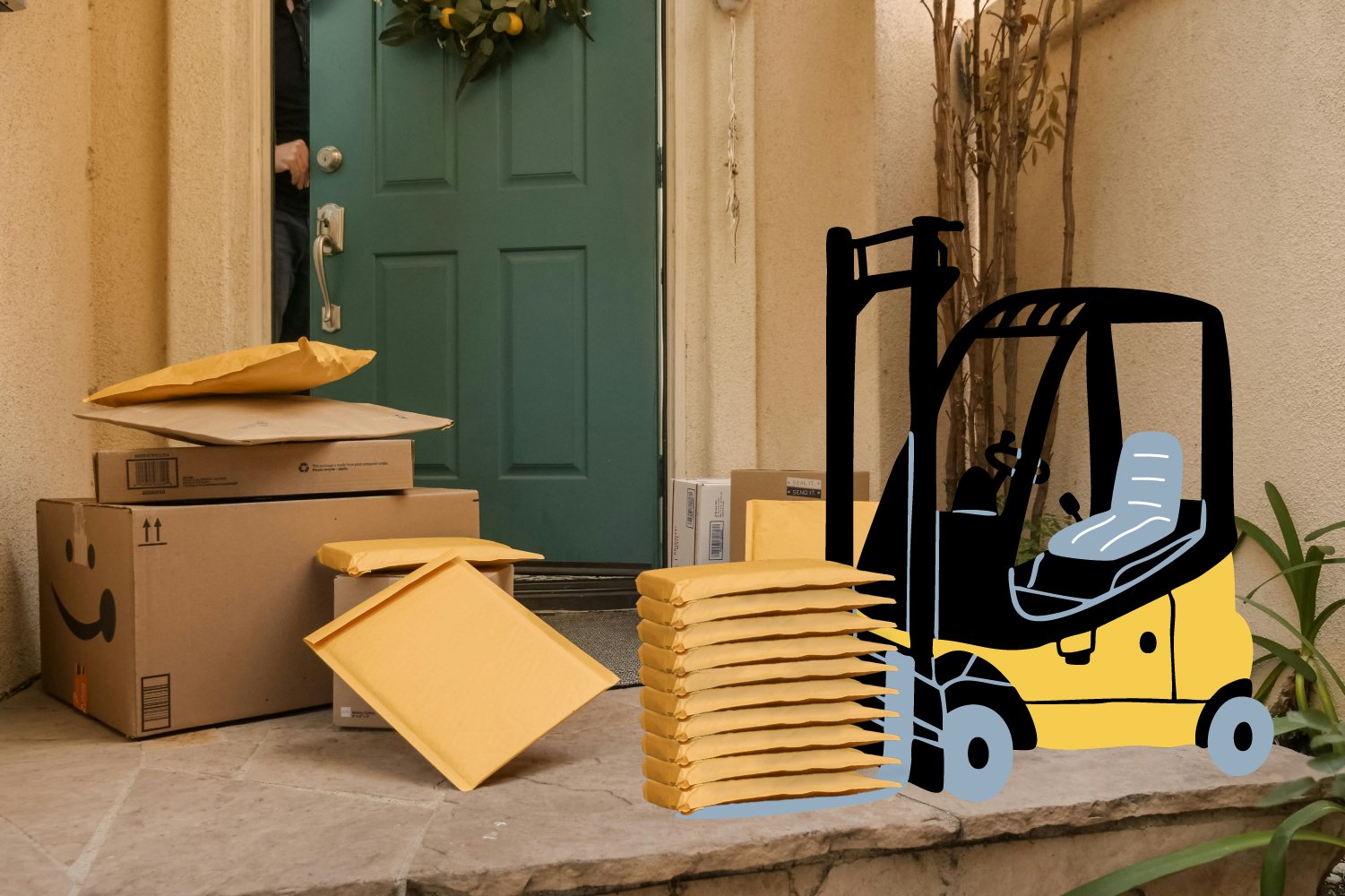50+ Ecommerce packaging statistics for smarter brands
Packaging is a vital consumer experience touchpoint, a brand perception driver, and a battleground for environmental responsibility. With increasing pressure to replace plastic and reduce environmental harm, ecommerce businesses are re-evaluating the materials, designs, and logistics behind every parcel they ship.
This article explores the latest ecommerce packaging statistics, illuminating the shifting landscape and the opportunities it offers to brands committed to both sustainability and profitability.
Types of packaging in ecommerce
The ecommerce industry is in its heyday and growing exponentially. We have the chance to make a meaningful impact, and changing packaging can send deep-felt ripples in sustaining the planet.
Here’s a breakdown of the top two contributors in the ecommerce packaging sector:
Corrugated boxes
They are somewhat lightweight and sturdy, and provide reasonable protection against shocks (when void fill is added) and environmental factors. These boxes come in various styles, which are economical and suitable for general warehousing and shipping.
In 2024, corrugated boxes accounted for a significant portion of the ecommerce packaging market, with the segment projected to reach $95.5 billion by 2030.¹
The corrugated boxes segment is growing at a compound annual growth rate (CAGR) of 17.6%.¹
Poly bags
These mailers are lightweight, flexible, and cost-effective, making them popular for shipping non-fragile items like clothing and accessories. Unfortunately, poly mailers are made of different types of plastic, and therefore take a toll on the environment.
In 2022, plastic pouches and bags accounted for about 31.7% of the total global plastic packaging weight in ecommerce.¹
The poly bags segment is expected to grow at a CAGR of 16.3% over the analysis period, reflecting their increasing use in ecommerce packaging.¹
The impact of packaging on customer loyalty
In ecommerce, postal packaging is like a brand ambassador for your company. Which is why it’s surprising to us that plastic package usage soared to 2.1 billion pounds in 2019.²
Your packaging is your customer's first tangible interaction with your brand. And in a market where aesthetics and sustainability are at the forefront of every unboxing, getting your packaging right is more important than ever. Plastic is dirt-cheap, and it also looks the part. Consider whether that’s the first impression you want your customers to have of your brand.
Here are some statistics on consumer experience with brand packaging.
27% of consumers won’t repurchase from the same retailer if the packaging isn’t sustainable.³
52% of consumers are more likely to repeat purchases if their orders are shipped in luxury packaging.³
81% of consumers now report receiving recyclable ecommerce packaging, up from 73% in 2021.³
11% of shoppers remain unsure whether they can recycle the packaging they receive.³
41% of consumers say that branded packaging encourages future orders.³
Customer loyalty can increase by 40% if packaging is personalised.³
65% of shoppers are willing to use “connected packaging” featuring QR codes or interactive elements.³
Sustainable packaging is becoming more prevalent with every parcel shipped. While recyclable packaging is often met with positivity, unclear recycling instructions can lead to customer dissatisfaction and a lower retention rate. Proper, easy instructions on recycling should be a given!
Customisation in ecommerce packaging is also highlighted, suggesting that customers can form an emotional bond with a company through its high-quality, sustainable packaging. Consumers show a need for improved packaging and access to sustainability information. Providing better ecommerce packaging will drive brand loyalty and longevity.
The impact of packaging on consumer behaviour
Packaging plays a pivotal role in shaping consumer behaviour in ecommerce, and ensuring your packaging conveys the message you intended it to has never been more serious than now.
Curated, plastic-free, and thought-through packaging can connect with the consumer physically and emotionally, driving engagement, brand loyalty, and awareness. Below are some statistics on how proper packaging can influence a consumer, drastically tipping the scale from plastic to sustainable materials.
52% of customers are more likely to purchase from an online retailer again if they liked their packaging, and if the packaging was premium.³⁶
3 out of 4 consumers confirmed that they are unsure whether the packaging they received is sustainable or not.³⁷
25% of online shoppers in the US indicated that sustainable packaging influences their decision to shop with specific brands. That’s more than 68 million potential customers.⁵
47% of consumers would be dissuaded from making another purchase if they perceive the packaging as excessive.⁷
53% of consumers received damaged goods from online purchases in the past year, and 57% would hesitate to shop with a retailer again after such an experience.⁸
50% of US consumers are willing to pay more for products with sustainable packaging, which further drives the need that consumers have not only for a product but for a safer planet.⁹
40% of shoppers shared photos of products with unique or branded packaging on social media, amplifying brand visibility and setting a benchmark for consumers to shop with brands that drive a difference in the health and longevity of the planet.⁵
72% of consumers agree that packaging design can sway their purchasing choices.⁴
Consumers increasingly favour brands that utilise recyclable packaging materials, with 60% citing sustainable packaging as a factor encouraging them to shop with a brand.¹⁰
63–67% of US shoppers believe products appear more premium when packaged in cardboard or paper rather than plastic.⁴
Packaging is your silent brand ambassador in a sector where every detail creates and defines perception. From influencing purchase decisions to inspiring brand longevity and social sharing, sustainable packaging can be your competitive edge.
Brands that make packaging matter will win conscious consumers' hearts (and repeat purchases). And although the delivery of the package might be out of your hands, safety is still your concern, and standard plastic just falls short compared to something like Bubble Wool.
Packaging and logistics
Proper, thought-through packaging is crucial in ecommerce logistics. It influences shipping costs, return rates, and the overall customer experience.
Implementing the right-sized packaging can significantly lower shipping expenses by minimising dimensional weight charges. Putting more significant profits for the company and lower prices for the consumer.11 Carriers often use dimensional weight pricing, meaning larger packages can incur higher shipping costs even if they are lightweight.¹⁶
Here are some statistics on how well-designed packaging can drive your brand to new heights:
20–30% of ecommerce purchases are returned, nearly double that of brick-and-mortar stores.¹²
Damaged or defective products are the number one reason a customer will return an item.¹²
80.2% of ecommerce returns are due to products arriving damaged, which clearly emphasises the need for robust packaging.¹³
63% of French people say they adopt “eco-friendly” purchasing practices, but only 1 in 5 people place environmental impact at the heart of their purchasing decision.³⁸
Price remains the primary criteria for 76% of buyers.³⁸
58% of shoppers won’t repurchase from a retailer if their order arrived damaged, highlighting the importance of first impressions that last and the need for protective packaging.³
Processing a return can cost retailers between 20–65% of the item's original value, leading to fewer return customers, and without a re-order, it is money lost by the company. All due to ineffective packaging.¹⁷
Protective and sustainable packaging pays off in every part of the ecommerce journey, from reducing costly returns and shipping fees to safeguarding customer trust and loyalty. For brands aiming to scale profitably and sustainably, the box your product arrives in is just as important as the product itself. See the table below for the most important buying factors as recorded in 2021.¹⁵
Source: Digitalcommerce360
The data above clearly shows that consumers are driven by price and that sustainability in shipping has declined. But what can be done about this? Consumers will continue buying products, so as the supplier, it’s your duty to ensure that your packaging is sustainable.
Technology and innovation in packaging
Advancements in technology and innovation are significantly transforming the ecommerce packaging landscape, enhancing efficiency, sustainability, and consumer engagement.
A compound annual growth rate (CAGR) of 13% is projected for the global ecommerce packaging market from $90.8 billion in 2025 to $272.77 billion by 2034.¹⁹
A CAGR of 8.63% in the worldwide demand for sustainable ecommerce packaging materials is projected, growing from USD 35.64 billion in 2024 to USD 81.55 billion by 2034.⁴⁰
56.8% of consumers consider sustainable packaging important or very important when purchasing online. This means they are willing to spend more or wait longer for their package.¹⁹
Companies implementing reusable packaging solutions have achieved return rates as high as 95%, indicating strong consumer participation in sustainability initiatives and showing consumers' engagement with brands that implement sustainability.¹⁹
Innovation in packaging is about more than just designing better boxes, but building a brighter, more sustainable future. As technology evolves and consumer expectations rise, brands that embrace innovative and sustainable solutions will stay competitive and lead the change.
Packaging and unit economics
Packaging is crucial to the unit economics of ecommerce companies, significantly affecting their expenses, profit margins, and customer satisfaction.
North America held a 33.35% share in the ecommerce packaging market in 2023.²³
The US market alone is projected to reach $21.31 billion by 2032, driven by increasing online purchasing behaviour.²³
In 2023, Chinese ecommerce giant JD.com plans to introduce 1.5 million units of reusable express packaging to reduce its use of single-use packaging entirely. By the end of 2024, the initiative anticipated eliminating over 100 million disposable packages. This means less costs go to packaging and more to profit and sustainability.²⁵
A 24% reduction in damage rates and substantial cost savings were experienced by Amazon by implementing a multi-stage approach that balances shipment and damage costs.²⁰
Utilising a decision-tree framework to select optimal box sizes for product shipments can reduce shipment volume by 4.4% and decrease non-utilised air volume space by 2.2%, contributing to cost efficiency and sustainability.²¹
Innovative packaging shouldn’t be seen as an expense, but rather as an investment in profitability and the planet. By optimising packaging choices, brands can reduce costs, minimise waste, and unlock more significant margins.
Regional differences in ecommerce packaging
Ecommerce packaging practices and market dynamics exhibit notable variations across different regions, influenced by consumer behaviour, regulatory environments, and technological advancements.
Here are some mindful statistics:
The Asia-Pacific region is projected to maintain the largest share of the ecommerce packaging market by 2028, fueled by booming online retail in countries like China and India.¹⁴
A 12.5% compound annual growth rate is projected for the North American ecommerce packaging market over the next five years, reflecting robust online shopping trends.²⁸
In 2023, the Asia-Pacific region led the global ecommerce flexible packaging market with a 39.75% share, expected to grow at a CAGR of 10.28% during the forecast period.¹⁹
Global ecommerce is now a full-scale race. From Asia-Pacific’s explosive growth to North America’s shifting standards and international giants like Amazon setting the pace. The future of ecommerce packaging is being shaped by those who adapt fast, think globally, and act sustainably.
Regional market size and CAGR for ecommerce packaging
| Region | Market Size (2023) | Projected Market Size (2030) | CAGR (2024–2030) |
|---|---|---|---|
| United States | $19.36 billion | $46.12 billion | 14.2% |
| Europe | $16.59 billion | $21.31 billion | 8.73% |
| Asia-Pacific | $37.79 billion | $138.90 billion | 20.4% |
It’s clear that Asia is the fastest-growing region for ecommerce, and this growth should be partnered with sustainability in mind.
Packaging during the holiday and peak seasons
The holiday and peak shopping seasons significantly influence ecommerce packaging strategies and operations.
An 8.4% increase from 2023 to 2024 was recorded in the US, with consumers spending a record $241 billion online during the holiday season. Leading to a massive surge in the ecommerce market.³⁰
In 2023, the fourth quarter ecommerce share was 16% above the Q1–Q3 average, indicating a significant rise in online shopping during the holiday season.⁶
During the holiday season, delivery companies like UPS and FedEx handle nearly 2.2 billion deliveries and returns between Thanksgiving and New Year's Eve in the US alone.³⁰
82% of consumers are willing to pay more for products with sustainable packaging, indicating a shift in purchasing priorities during the holiday season.³²
90% of holiday shoppers reported that inflation would impact their spending decisions, increasing price sensitivity and demand volatility.³³
Mobile spending during the 2024 holiday season accounted for $128 billion, reflecting the growing importance of mobile-friendly shopping experiences.³⁰
The holiday season often sees a surge in product returns, with ecommerce return rates averaging between 20–30%, nearly double that of brick-and-mortar stores.¹⁴
An estimated 12 million people in the UK have injured themselves attempting to open difficult packaging during the holiday season, highlighting the need for user-friendly designs.³⁴
The festive season isn’t solely focused on increased sales. It comes with more significant challenges: with billions being spent, dispatched, and returned in unprecedented speed, your packaging needs to achieve more than just protection. It should leave a lasting impression. Brands focusing on creative and sustainable packaging will be what customers recall well beyond the holiday season.
The future of ecommerce packaging
The ecommerce packaging sector is experiencing a remarkable transition, powered by great technological innovations, a growing commitment to sustainability, and consumers' evolving desires.
9.5% CAGR is expected for corrugated packaging through 2029, reflecting its increasing adoption in ecommerce.³⁵
Luxury group LVMH Moët Hennessy Louis Vuitton launched LIFE360 (LVMH Initiatives for the Environment), and aim to have zero virgin fossil-based plastic in packaging by 2026.³⁹
In 2024, 97% of the Maisons (biggest brands under the LVMH group) introduced new circular services in everything from production to distribution.³⁹
The full package
The issue of packaging waste isn’t just a problem for your logistics team to solve. It makes a big statement about your brand's ethos, and should be top of mind for your procurement and marketing teams, too. Every box, wrap, or mailer is a chance to show what your business stands for.
In the ecommerce sector, where customers may never walk into your store, packaging is the one physical moment they remember. It can either tell a story or be forgotten.
At Woola, we believe the story should be one of care for your product, customer, and the planet. That’s why we’ve turned waste wool into something beautiful, functional, and radically sustainable.
If you're ready to ditch the plastic and lead with purpose, request a Woola sample or talk to our team. Let’s make packaging part of the climate change solution, not the problem.
Sources
- GlobeNewswire — Market Forecast to 2030
- Statista — Global Plastic Packaging Use
- GWP — Best eCommerce Packaging
- BusinessDasher — Importance of Packaging
- Statista — Packaging & Shopping Behavior (US)
- Statista — eCommerce Share in US Retail
- Mondi Group — Packaging Trends 2024
- New York Post — Damaged Packages Soaring
- Meyers — Packaging & Printing Stats
- PackagingTechToday — Packaging Impacts Purchases
- Wikipedia — Dimensional Weight
- Richpanel — Ecommerce Return Rates
- MeteorSpace — Return Statistics
- MeteorSpace — Packaging Stats 2025
- DigitalCommerce360 — Shoppers Prefer Sustainable Shipping
- Shopify — Ecommerce Returns
- Wikipedia — RePack
- Towards Packaging — Market Insights
- arXiv — AI for Packaging Optimization
- arXiv — Box Size Optimization with Trees
- Grand View Research — ecommerce Packaging Report
- Fortune Business Insights — Market Overview
- Medium — Unit Economics of ecommerce
- GM Insights — Sustainable Packaging Market
- Oceana — Amazon Plastic Report
- GlobeNewswire — US ecommerce Packaging Forecast
- Mordor Intelligence — North America Market
- The Verge — Amazon Drops Plastic Pillows
- IdeaGrove — Holiday Packaging Insights
- Reuters — UPS/FedEx Holiday Readiness
- Ranpak — Packaging Outlook 2024
- Veryable — On-Demand Labor for Peak Season
- The Sun — Holiday Packaging Injuries
- Smithers — Future of ecommerce Packaging
- Towards Packaging — Corrugated Boxes Market Size, Demand, and Trends Analysis 2034
- Packaging of the world — The Power of Packaging You Probably Did Not Know About
- Woola — Ecommerce and sustainable packaging report
- Woola — Ecommerce and eco-responsibility study
- LVMH — Commitment in action
- GlobeNewsWire — Sustainable E-Commerce Packaging Market 2025






